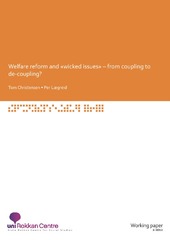| dc.contributor.author | Christensen, Tom | eng |
| dc.contributor.author | Lægreid, Per | eng |
| dc.date.accessioned | 2012-09-14T11:20:03Z | |
| dc.date.accessioned | 2020-12-10T06:35:06Z | |
| dc.date.available | 2012-09-14T11:20:03Z | |
| dc.date.available | 2020-12-10T06:35:06Z | |
| dc.date.issued | 2012-04 | eng |
| dc.identifier.issn | 1503-0946 | |
| dc.identifier.uri | https://hdl.handle.net/1956/6005 | |
| dc.description | This paper was presented at the 2012 Structure of Government (SOG) Conference «Public Policy and Public Management: Exploring the Changing Linkages», Melbourne January 27-29, 2012. It is part of the research project Reforming the Welfare State. Democracy, Accountability and Management and also the project on Evaluation of NAV, both funded by the Norwegian Research Council. It is also linked to the Coordination for Cohesion in the Public Sector of the Future (COCOPS) project, Work Package 5 on Innovative Coordination Practices in Public Management, funded by the EU’s 7th Framework Program. | eng |
| dc.description.abstract | This paper seeks to identify trans-boundary innovative coordination practices and related modes of specialization and steering instruments in welfare administration reforms. We describe how the 2005 reform of the welfare administration in Norway started as a coupling process involving merger and partnership, but later, following the 2008 reorganization, introduced re-centralization and re-specialization, which implied decoupling. The main research questions are how we can explain this change from coupling to de-coupling of administrative reform and policy delivery? What are the main actors and interests behind it? What are the changes in organizing principles experienced? Why was the administrative reform not sustainable and reorganization through decoupling seen as a better answer to the «wicked issues» of welfare services? To answer these questions we apply a transformative theoretical approach, which combines a structural-instrumental perspective, a cultural-institutional perspective and an environmental perspective. | en_US |
| dc.description.abstract | Dette notatet tar sikte på å identifisere grenseoverskridende innovativ samordningspraksis og tilknyttede spesialiseringsformer og styringsinstrumenter i velferdsstatsreformer. Vi beskriver hvordan NAV reformen i 2005 startet som er koplingsprosess preget av sammenslåinger og partnerskap. Men gjennom reorganiseringen i 2008 ble respesialisering og resentralisering introdusert noe som medførte de-kopling. Hovedproblemstillingen er hvordan vi kan forklare denne endringen fra kopling til dekopling i NAV-reformen. Hvem er de sentrale aktørene og interessene bak disse prosessene? Hvilke endringer i organisasjonsprinsipper kan observeres, og hvorfor oppleves disse som bedre egnet til å håndtere vanskelige problemer knyttet til tjenesteproduksjonen i NAV. For å svare på disse problemene benyttes en transformativ teoretisk tilnærming som kombinerer et strukturelt-instrumentelt perspektiv, et kulturelt-institusjonelt perspektiv og et omgivelsesperspektiv. | en_US |
| dc.language.iso | eng | eng |
| dc.publisher | Stein Rokkan Centre for Social Studies | eng |
| dc.relation.ispartofseries | Working Paper | eng |
| dc.relation.ispartofseries | 02-2012 | eng |
| dc.title | Welfare reform and «wicked issues» – from coupling to de-coupling? | eng |
| dc.type | Working paper | eng |
| dc.rights.holder | Copyright Stein Rokkan Centre for Social Studies. All rights reserved | |
| dc.subject.nsi | VDP::Samfunnsvitenskap: 200 | nob |
